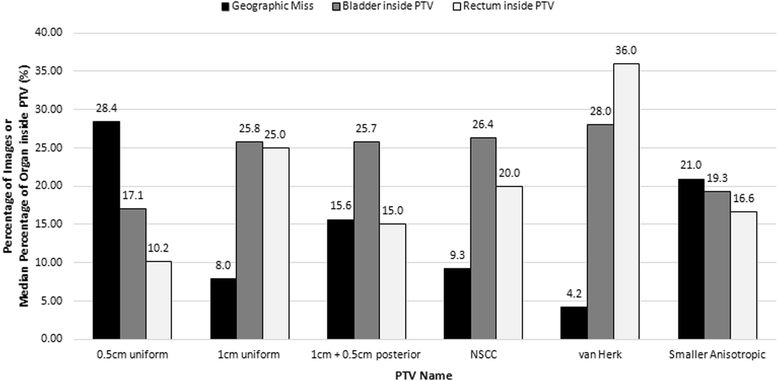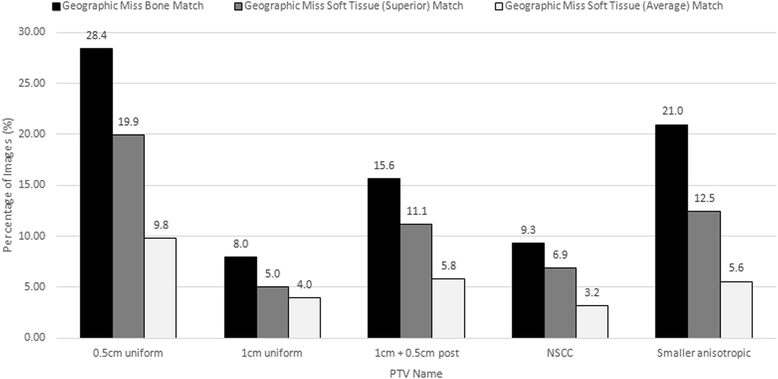Determining optimal planning target volume and image guidance policy for post-prostatectomy intensity modulated radiotherapy
- PMID: 26209446
- PMCID: PMC4514953
- DOI: 10.1186/s13014-015-0467-8
Determining optimal planning target volume and image guidance policy for post-prostatectomy intensity modulated radiotherapy
Abstract
Background: There is limited information available on the optimal Planning Target Volume (PTV) expansions and image guidance for post-prostatectomy intensity modulated radiotherapy (PP-IMRT). As the prostate bed does not move in a uniform manner, there is a rationale for anisotropic PTV margins with matching to soft tissue. The aim of this study is to find the combination of PTV expansion and image guidance policy for PP-IMRT that provides the best balance of target coverage whilst minimising dose to the organs at risk.
Methods: The Cone Beam CT (CBCT) images (n = 377) of 40 patients who received PP-IMRT with daily online alignment to bony anatomy (BA) were reviewed. Six different PTV expansions were assessed: 3 published PTV expansions (0.5 cm uniform, 1 cm uniform, and 1 + 0.5 cm posterior) and 3 further anisotropic PTV expansions (Northern Sydney Cancer Centre (NSCC), van Herk, and smaller anisotropic). Each was assessed for size, bladder and rectum coverage and geographic miss. Each CBCT was rematched using a superior soft tissue (SST) and averaged soft tissue (AST) match. Potential geographic miss was assessed using all PTV expansions except the van Herk margin.
Results: The 0.5 cm uniform expansion yielded the smallest PTV (median volume = 222.3 cc) and the 1 cm uniform expansion yielded the largest (361.7 cc). The Van Herk expansion includes the largest amount of bladder (28.0 %) and rectum (36.0 %) and the 0.5 cm uniform expansion the smallest (17.1 % bladder; 10.2 % rectum). The van Herk PTV expansion had the least geographic miss with BA matching (4.2 %) and the 0.5 cm uniform margin (28.4 %) the greatest. BA matching resulted in the highest geographic miss rate for all PTVs, followed by SST matching and AST matching. Changing from BA to an AST match decreases potential geographic miss by half to two thirds, depending on the PTV expansion, to <10 % for all PTV expansions. When using the smaller anisotropic PTV expansion, AST matching would reduce the geographic miss rate from 21.0 % with BA matching down to 5.6 %.
Conclusions: Our results suggest the optimal PTV expansion and image guidance policy for PP-IMRT is daily average soft tissue matching using CBCT scans with a small anisotropic PTV expansion of 0.5 cm in all directions apart from a 1 cm expansion in the anterior-posterior direction in the upper prostate bed. Care must be taken to ensure adequate training of Radiation Therapists to perform soft tissue matching with CBCT scans.
Figures




References
-
- Simpson DR, Einck JP, Nath SK, Sethi RA, Wang JZ, Mundt AJ, Sandhu AP. Comparison of daily cone-beam computed tomography and kilovoltage planar imaging for target localization in prostate cancer patients following radical prostatectomy. Practical Radiation Oncology. 2011;1:156–162. doi: 10.1016/j.prro.2010.12.002. - DOI - PubMed
MeSH terms
LinkOut - more resources
Full Text Sources
Other Literature Sources
Medical
Research Materials
Miscellaneous

